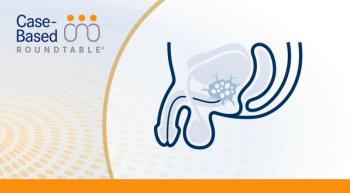
Targeted Therapies in Oncology
- September 2022
- Volume 11
- Issue 12
- Pages: 59
Neoadjuvant Combination Improves MRD Rates in High-Risk Prostate Cancer
Positive findings were reported from the phase 2 ARNEO trial during the European Association of Urology Congress 2022.
Neoadjuvant degarelix (Firmagon) , a hormone therapy, led to a higher likelihood of achieving minimal residual disease (MRD) negativity when used in combination with apalutamide (Erleada) compared with degarelix alone in patients with high-risk prostate cancer after radical prostatectomy, according to findings from the phase 2 ARNEO trial (NCT03080116).
MRD levels below 0.25 mL, the primary end point of the trial, was achieved in 38% of patients in the apalutamide combination arm (n = 45) compared with 9% in the degarelix monotherapy arm (n = 44; risk ratio, 4.2; P = .002). The residual cancer burden was a median of 0.48 mL with the doublet and 1.7 mL with the single agent (P < .001).
“Patients [with high-risk prostate cancer] treated with degarelix plus apalutamide achieved a signifi cantly better tumor response compared [with] the patients treated with degarelix plus matching placebo,” said Steven Joniau, MD, PhD, a consulting urologist and assistant professor in the Department of Urology at University Hospitals Leuven in Belgium, when presenting fi ndings from the ARNEO trial during the European Association of Urology Congress 2022.
Downstaging was more common following treatment with apalutamide and degarelix than with degarelix and placebo. In the combination arm, downstaging to pT2 occurred in 51% of patients compared with 27% in the monotherapy arm (P = .03), and downstaging to pT3a occurred in 27% and 39%, respectively.
The probability of biochemical recurrence was significantly reduced in patients who achieved pathologic complete response to treatment and had MRD negativity compared with those who had MRD positivity. “Deep pathological response was correlated with less or almost no risk of biochemical progression,” Joniau said.
Historically, clinical trials have not shown a survival benefit for neoadjuvant treatment prior to radical prostatectomy despite demonstration of pathological response, but Joniau noted that these studies explored the use of first-generation antiandrogens in men with low- and intermediate-risk prostate cancer. However, one retrospective analysis did show a survival benefit for neoadjuvant hormonal therapy in patients with high-risk prostate cancer. The analysis showed that the risk of prostate cancer–related death was decreased by 50% with neoadjuvant treatment (P = .0014), but it was suggested that it could have been due in part to the use of radiotherapy after surgery.2
The ARNEO study enrolled patients with high-risk nonmetastatic prostate cancer who had a prostate-specifi c antigen (PSA) level higher than 20 ng/mL, a Gleason score between 8 and 10, and/or 2 to 3 intermediate risk factors. Statistical analysis required at least 84 patients to be enrolled. Patients were randomly assigned to receive either neoadjuvant degarelix and apalutamide or degarelix and placebo for 3 months prior to surgery. Blinded prostate-specifi c membrane antigen (PSMA) PET/MRI scans were conducted before and after treatment. The primary end point was MRD rate, and secondary end points included PSA kinetics, toxicity, quality of life, and biomarkers for pathological response.
At baseline in the combination arm, the median PSA level was 12.6 ng/mL, and most patients had cT3a disease (40%) and an International Society of Urological Pathology (ISUP) grade of 5 (43%). Comparatively in the degarelix monotherapy arm, the median PSA level was 11.2 ng/mL, and most patients had cT3a disease (46%) and ISUP grade 4 disease (39%).
Both PSMA PET estimated volume (P < .0001) and PSMA maximum standard uptake value (P < .0001) after neoadjuvant therapy were correlated with cancer volume at fi nal pathology and pathological response. PTEN loss was considered a negative predictor for MRD, as patients with PTEN loss at baseline were less likely to achieve MRD (11% vs 43% with PTEN; P = .002). Joniau concluded that this study was a solid foundation for ongoing and planned phase 3 trials in this setting.
REFERENCES:
1. Devos G, Tosco L, Baldewijns M, et al. ARNEO: a randomized phase II trial of neoadjuvant degarelix with or without apalutamide prior to radical prostatectomy for high-risk prostate cancer. Presented at: European Association of Urology Congress 2022; July 1-4, 2022; Amsterdam, Netherlands.
2. Tosco L, Laenen A, Briganti A, et al. The survival impact of neoadjuvant hormonal therapy before radical prostatectomy for treatment of high-risk prostate cancer. Prostate Cancer Prostatic Dis. 2017;20(4):407-412. doi:10.1038/pcan.2017.29
Articles in this issue
about 3 years ago
Emerging Biomarkers Inform Therapy Choice in HR+ Breast Cancerabout 3 years ago
Pandemic Spurs Clinical Trial Organizers to Seek New Career Pathabout 3 years ago
Pembrolizumab Delays Disease and Distant Metastasis in RCCabout 3 years ago
As CLL Approaches Expand, Sequencing Questions Arise








































